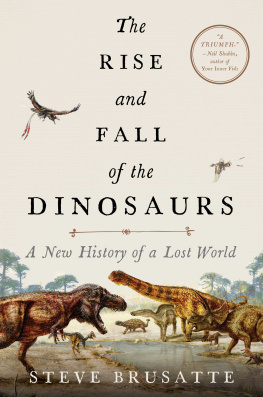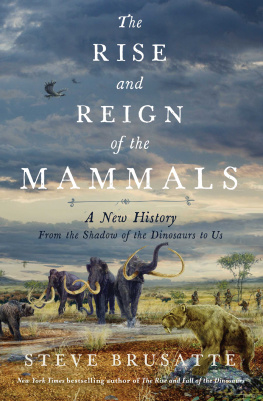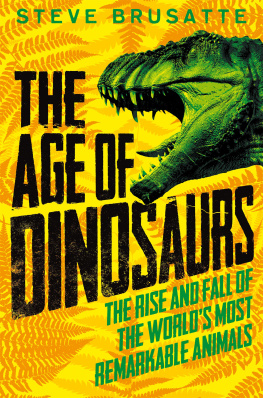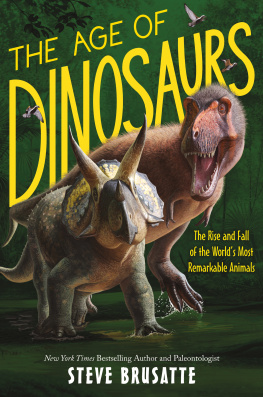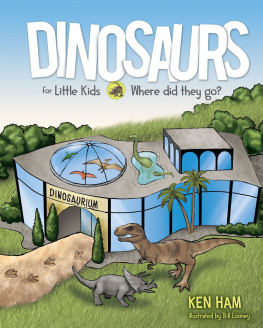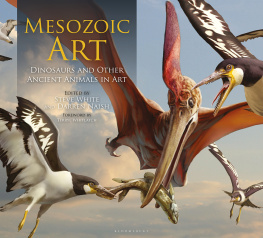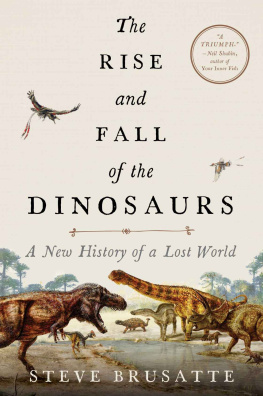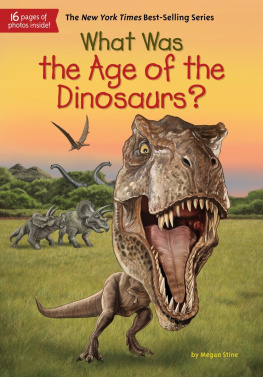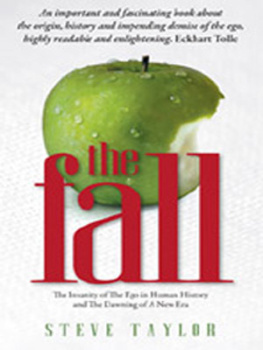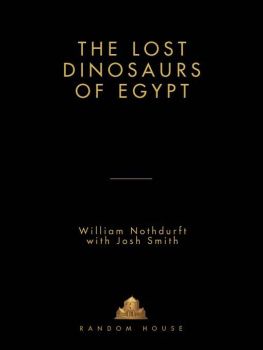Steve Brusatte - The Rise and Fall of the Dinosaurs: A New History of a Lost World
Here you can read online Steve Brusatte - The Rise and Fall of the Dinosaurs: A New History of a Lost World full text of the book (entire story) in english for free. Download pdf and epub, get meaning, cover and reviews about this ebook. year: 2018, publisher: William Morrow, genre: History. Description of the work, (preface) as well as reviews are available. Best literature library LitArk.com created for fans of good reading and offers a wide selection of genres:
Romance novel
Science fiction
Adventure
Detective
Science
History
Home and family
Prose
Art
Politics
Computer
Non-fiction
Religion
Business
Children
Humor
Choose a favorite category and find really read worthwhile books. Enjoy immersion in the world of imagination, feel the emotions of the characters or learn something new for yourself, make an fascinating discovery.
- Book:The Rise and Fall of the Dinosaurs: A New History of a Lost World
- Author:
- Publisher:William Morrow
- Genre:
- Year:2018
- Rating:5 / 5
- Favourites:Add to favourites
- Your mark:
- 100
- 1
- 2
- 3
- 4
- 5
The Rise and Fall of the Dinosaurs: A New History of a Lost World: summary, description and annotation
We offer to read an annotation, description, summary or preface (depends on what the author of the book "The Rise and Fall of the Dinosaurs: A New History of a Lost World" wrote himself). If you haven't found the necessary information about the book — write in the comments, we will try to find it.
The Rise and Fall of the Dinosaurs: A New History of a Lost World — read online for free the complete book (whole text) full work
Below is the text of the book, divided by pages. System saving the place of the last page read, allows you to conveniently read the book "The Rise and Fall of the Dinosaurs: A New History of a Lost World" online for free, without having to search again every time where you left off. Put a bookmark, and you can go to the page where you finished reading at any time.
Font size:
Interval:
Bookmark:
For Mr. Jakupcak, my first and finest teacher of paleontology,
and my wife, Anne, and all others teaching the next generation.
Contents

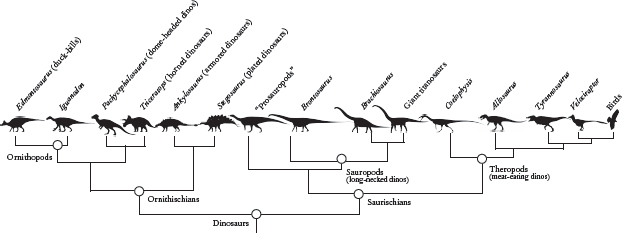

Triassic Period (ca. 220 million years ago)
World Maps of the Prehistoric Earth 2016 Colorado Plateau Geosystems, Inc.

Late Jurassic Period (ca. 150 million years ago)
World Maps of the Prehistoric Earth 2016 Colorado Plateau Geosystems, Inc.

Late Cretaceous Period (ca. 80 million years ago)
World Maps of the Prehistoric Earth 2016 Colorado Plateau Geosystems, Inc.

Zhenyuanlong
Chapter Title art by Todd Marshall
A FEW HOURS BEFORE LIGHT broke on a cold November morning in 2014, I got out of a taxi and pushed my way into Beijings central railway station. I clutched my ticket as I fought through a swarm of thousands of early-morning commuters, my nerves starting to jangle as the departure time for my train ticked ever closer. I had no idea where to go. Alone, with only a few words of Chinese in my vocabulary, all I could do was try to match the pictographic characters on my ticket to the symbols on the platforms. Tunnel vision set in, and I barreled up and down the escalators, past the newsstands and noodle joints, like a predator on the hunt. My suitcaseweighed down with cameras, a tripod, and other scientific gearbounced along behind me, rolling over feet and smacking into shins. Angry shouts seemed to come at me from all directions. But I didnt stop.
By now sweat was pouring through my downy winter jacket, and I was gasping in the diesel haze. An engine roared to life somewhere ahead of me, and a whistle sounded. A train was about to depart. I staggered down the concrete steps leading to the tracks and, to my great relief, recognized the symbols. Finally. This was my trainthe one that would be shooting northeastward to Jinzhou, a Chicago-size city in old Manchuria, a few hundred miles from the frontier with North Korea.
For the next four hours, I tried to get comfortable as we crawled past concrete factories and hazy cornfields. Occasionally I nodded off, but I couldnt steal back much sleep. I was far too excited. A mystery was waiting at the end of the journeya fossil that a farmer stumbled upon while harvesting his crops. I had seen a few grainy photos, sent to me by my good friend and colleague Junchang L, one of Chinas most famous dinosaur hunters. We both agreed it looked important. Maybe even one of those holy grail fossilsa new species, preserved in such an immaculate way that we can sense what it was like as a living, breathing creature tens of millions of years in the past. But we needed to see it ourselves to be sure.
When Junchang and I stepped off the train in Jinzhou, we were greeted by a band of local dignitaries, who took our bags and ushered us into two black SUVs. We were whizzed off to the citys museum, a surprisingly nondescript building on the outskirts of town. With the seriousness of a high-level political summit, we were led through the flickering neon lights of a long hallway, into a side room with a couple of desks and chairs. Balanced on a small table was a slab of rock so heavy that it seemed the legs were starting to buckle. One of the locals spoke in Chinese to Junchang, who then turned to me and gave a quick nod.
Lets go, he said, in his curiously accented English, a combination of the Chinese cadence he grew up with and the Texas drawl that he picked up as a grad student in America.
The two of us came together and stepped toward the table. I could feel the eyes of everyone, an eerie silence hanging over the room as we approached the treasure.
Before me was one of the most beautiful fossils I had ever seen. It was a skeleton, about the size of a mule, its chocolate-brown bones standing out from the dull gray limestone surrounding it. A dinosaur for sure, its steak-knife teeth, pointy claws, and long tail leaving no doubt that it was a close cousin of Jurassic Parks villainous Velociraptor.
But this was no ordinary dinosaur. Its bones were light and hollow, its legs long and skinny like a herons, its slender skeleton the hallmark of an active, dynamic, fast-moving animal. And not only were there bones, but there were feathers covering the entire body. Bushy feathers that looked like hair on the head and neck, long branching feathers on the tail, and big quill pens on the arms, lined together and layered over each other to form wings.
This dinosaur looked just like a bird.
About a year later, Junchang and I described this skeleton as a new species, which we called Zhenyuanlong suni. It is one of about fifteen new dinosaurs that Ive identified over the past decade, as Ive carved out a career in paleontology that has taken me from my roots in the American Midwest to a faculty job in Scotland, with many stops all over the world to find and study dinosaurs.
Zhenyuanlong is unlike the dinosaurs I learned about in elementary school, before I became a scientist. I was taught that dinosaurs were big, scaly, stupid brutes so ill equipped for their environment that they just lumbered around, biding their time, waiting to go extinct. Evolutionary failures. Dead ends in the history of life. Primitive beasts that came and went, long before humans came on the scene, in a primeval world that was so different from today that it may as well have been an alien planet. Dinosaurs were curiosities to see in museums, or movie monsters that haunted our nightmares, or objects of childhood fascination, pretty much irrelevant to us today and unworthy of any serious study.
But these stereotypes are absurdly wrong. Theyve been dismantled over the past few decades, as a new generation has collected dinosaur fossils at an unprecedented rate. Somewhere around the worldfrom the deserts of Argentina to the frozen wastelands of Alaskaa new species of dinosaur is currently being found, on average, once a week. Let that sink in: a new dinosaur every... single... week. Thats about fifty new species each yearZhenyuanlong among them. And its not only new discoveries but also novel ways of studying thememerging technologies that help paleontologists understand the biology and evolution of dinosaurs in ways that our elders would have found unimaginable. CAT scanners are being used to study dinosaur brains and senses, computer models tell us how they moved, and high-power microscopes can even reveal what color some of them were. And so on.

Zhenyuanlong.
Photo courtesy of the author
Its been my great privilege to be part of this excitementas one of many young paleontologists from across the globe, men and women from many backgrounds who came of age in the era of
Font size:
Interval:
Bookmark:
Similar books «The Rise and Fall of the Dinosaurs: A New History of a Lost World»
Look at similar books to The Rise and Fall of the Dinosaurs: A New History of a Lost World. We have selected literature similar in name and meaning in the hope of providing readers with more options to find new, interesting, not yet read works.
Discussion, reviews of the book The Rise and Fall of the Dinosaurs: A New History of a Lost World and just readers' own opinions. Leave your comments, write what you think about the work, its meaning or the main characters. Specify what exactly you liked and what you didn't like, and why you think so.

